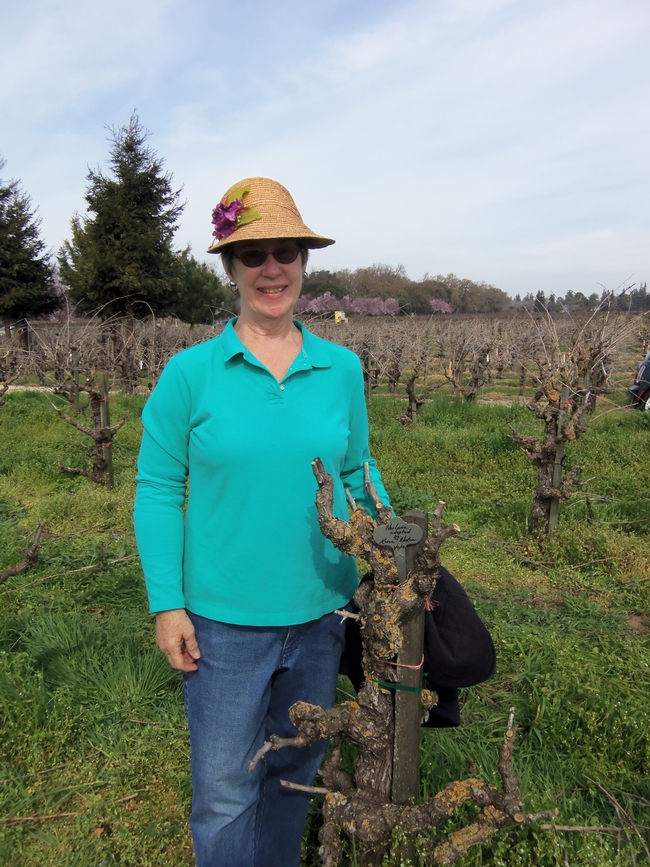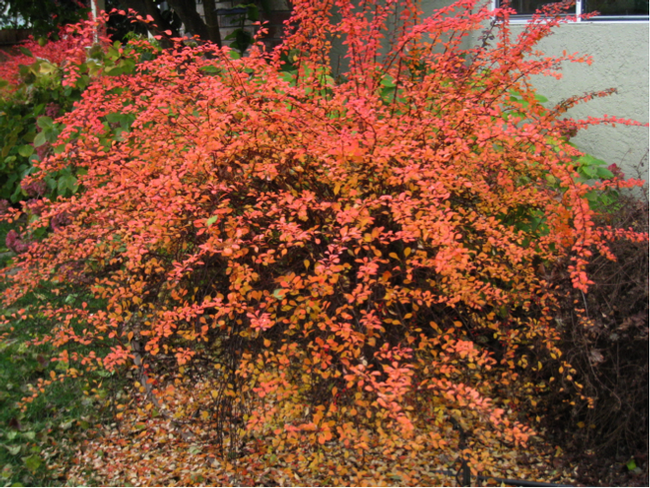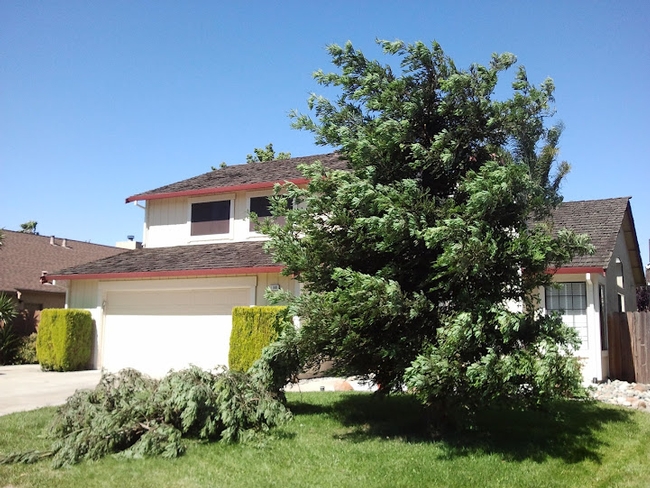Posts Tagged: pruning
Adopted Vine in Lodi
Yes, this is my first adoption and it is a 'Zinfandel' vine on the property of Lucas Winery in Lodi. The vines in this California Certified Organic Farm, CCOF, are over 80 years old. A friend took me there to celebrate my birthday and I saw an opportunity to take part in the winery’s educational series. At the first event in March, we learned how to do spring pruning of the vine. Winemaker and owner, Heather Lucas demonstrated how to prune the spurs from the “arms” of the vine. The idea is to prune away any spurs, except one that is closest to the arm. Then on the remaining spur it is pruned down to two buds. This sounds easy, but there are agonizing decisions to make. Should the thicker spur remain even though it is further away on the arm? It is often just a judgment call, as we saw Heather and her husband, David, discuss their cuts. Well, we will see what happens at the next class in May, when we go back to remove weak shoots to help the vine produce the best quality wine.

Karen and her vine.

Heather Lucas pruning.
Taming the Japanese Barberry
Oh, what a glorious sight is my Japanese Barberry-- Berberis thunbergii 'Rose Glow' in the fall! I have several planted around my yard and their lovely arching branches are graceful in the garden at any time, but in the fall: WOW! They can be breathtaking. I'd say they are worth the trouble to grow, but they are really no trouble to grow at all. In fact, they grow vigorously, are not fussy about soil, can take extreme heat and cold and will reach heights of 4 to 6 feet in just a few years. Therein, however, can lie a bit of "trouble"--at least for the hesitant pruner like me. I tend to let things grow naturally until one day I notice that they are shading out the lawn, blocking the path, threatening to overtake the house....you get the picture. And the barberry, in all its loveliness, does have one other little issue. It has thorns. No, no like rose thorns. These guys have strong, slender needle-like thorns that can reach over half an inch in length. So pruning a barberry can be a dangerous sport.
With that in mind I finally had had enough. The one that would no longer allow us to use our nice, stepping-stone path had to go. I gingerly lopped off branches in short pieces trying to keep my legs, arms, neck and face away from the thorns. But the branches all weave together and it was difficult to disentangle what I'd just cut. And then picking up the cut branches from the ground was another painful issue. Ah-ha! I got out my pitchfork, whose nice long handle kept me safe as I finished my job. Finally, getting close to the trunk I took my husband's chain saw and took the whole shrub down to about 4 inches high. The plan was to have my husband then dig it out. Well, a year later the shrub had yet to be removed and, lo and behold, it sent out nice little arching branches that did not reach into forbidden territory. I decided I like it again.
So this year I'm addressing the other 3 gigantic barberries in my yard. Now that I know how tough they are I feel brave, powerful...unleashed! I'm shearing them all (long gloves, loppers and especially my pitch fork at the ready) and taking back my yard. And in November I will be so happy to see them glowing again in the autumn light.
My recommendation: Don't be afraid of the Japanese Barberry. Just be sure you prune it hard--and have a pitchfork handy!

Photos by Marian Chmieleski

IMG 4245

IMG 4252

IMG 4255
'Tis time for the Big Chop
Rose fanciers know to prune their bloomers in late January or early February. I am not a fancier of roses, and thus do not have to worry myself with that chore. However, I do have a yard filled with California and Mediterranean native plants — and dozens of meadow grasses — that require some attention right about now.
Haircuts all around? You betcha.
Our back yard landscaping is not labor-intensive, but the Big Chop, as we call it, does take several days to complete. It’s multifunctional, really. It allows us to clean up around all the plantings, raking up (often by hand) the last of the fallen leaves. This cuts down on the hiding places that insects will find once the weather warms. It also makes the plantings look so much tidier; the yard looks newly planted, really.
We must start the Big Chop with an empty green waste toter, and maybe even pirate a neighbor’s for backup. Then the loppers come out, and the cutting begins. The butterfly bushes come down, from 7 feet tall to just 8-10 inches. Most of the salvias will also decrease in size by a third or so. The penstemons require a little less trimming, but a cleanup they will get. The catmint practically disappears, leaving just an inch or two of woody stems bristling above the soil line.
But those meadow grasses … they’re still looking pretty, especially the tall, billowy zebra grasses (Miscanthus sinensis 'Zebrinus'). They’ve faded to a bright gold, and their broomlike heads sway in the wind. I think I’ll save them for the last cut.
Are any of you prepping for a Big Chop of your own? Best of luck! May your backs not ache too much by the time you’re done.

The gold color of the now-dormant zebra grass makes it a standout. But it will soon fall during the Big Chop, as will the butterfly bushes to the left. Photo by Kathy Thomas-Rico
Ok, Now What Do I Do?
When we first moved into our “new” home (it was new then) over 20 years ago, it was obvious that something needed to be done about the “back forty”! Not only was the area free of any desirable vegetation, but with the only single-story house in the area, we were living in a goldfish bowl!! We couldn’t see into the neighbors’ homes, but they could sure peer into ours. This was brought to my attention when in the family room – I felt as though someone or something was staring at me. After going through a list of no-no’s not to do in public, I finally went to the large window and looked around – there she was, a small girl of 7 or 8 staring through HER window and into my house; she was watching me!
That was the beginning of the Betsy “hurry-up-and-plant-things around the fences “plan. A lot of thought went into was going to be planted and, of course, what wasn’t allowed on the property. Among the selections were fast growing shrubs such as oleander (Nerium oleander), pomegranate (Punica granatum), various climbing roses, as well as wax privets (Ligustrum japonicum), acceptable landscape plants that were easily found, easily planted, and easily grown. Now the years have past and the little girl was replaced by a teenager who didn’t care what was going on in nearby homes! This is the year that the “jungle without” is going to be tamed.
The wax privets have been pruned to multi-stem standards whose canopies just graze the fence tops on the South side of the house. The original pomegranate still is only giving small fruits which split as they ripen; the newer pomegranates are bending with 6-8 inch diameter fruits which are bright and cheery during this season of brown and yellowing leaves. The oleanders are providing shelter for the multitude of birds which stay in the yard for up to weeks at a time and then head South or where ever to join up with more of their kind. The hawthorn tree (Crataegus cordata) is full of berries, waiting for the birds to come and eat away. The weeds are popping up to thwart my best laid plans to have fewer grass weeds next spring and all in all peace is in the garden!
Back to my original query, anyone out there available to hack a path with me back to those luscious pomegranates? The only way to locate my little dog back there is to watch for the violently waving stems and stalks.
A little more pruning, thinning, and plant removal, and I will have the yard of my dreams (I think!).
Redwood Damage
The winds of late spring are an uncomfortable reality in Solano County. They blew through on June 8 and 9, blustery, drying north winds that disrupted graduation ceremonies, outdoor weddings and picnics at the park. Broken tree branches and piles of leaves and twigs, pushed up against north-facing fences and gutters, were evidence of the onslaught.
A realist would shrug off the loss of large branches as Mother Nature’s rather brutal pruning plan. Sometimes that’s a hard pill to swallow. A friend of ours lost the top third of a redwood tree planted in his front-yard lawn. When I heard this, I immediately thought of another friend who had recently told me about losing the top portion of a redwood tree on her property. Turns out, that loss was due to lack of water, but both of my friends now face a tricky situation: What do you do with a fast-growing evergreen that loses its terminal bud leader?
Redwoods that have been topped — whether by nature or humans — tend to freak out, sprouting from masses of dormant buds just below the topping cut and under the bark. This results in an extremely fast-growing tangled mess of unstable branches where once there was one tidy and elegant trunk. These masses are weak and tend to peel away in strong winds (which we know will return in late spring).
What my friends now face is quite possibly annual pruning of those redwoods. They must be prepared to maintain the sprouts and trim any large branches regularly. And they should consult with a certified arborist to do this work.
Redwood trees are considered to be wind-resistant trees. It appears my friend’s front-yard tree, though robust and healthy in appearance, faced prior stress and had become weakened somewhere along the way. Leave it to the winds of late spring to test that stress. Maybe it’s Mother Nature’s pruning plan after all.

Late spring’s strong north winds caused this otherwise healthy redwood tree to lose its leader. The tree is located in southeast Vacaville. (photo by Ken Williams)

